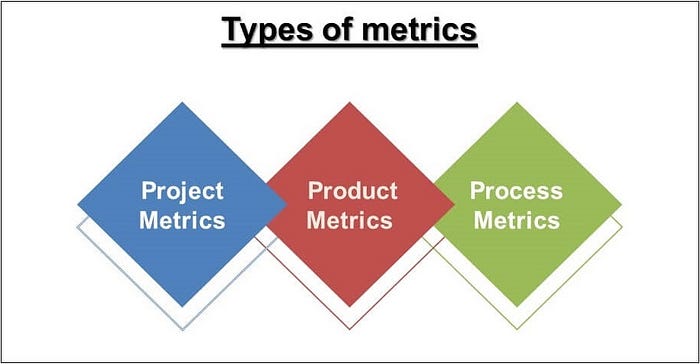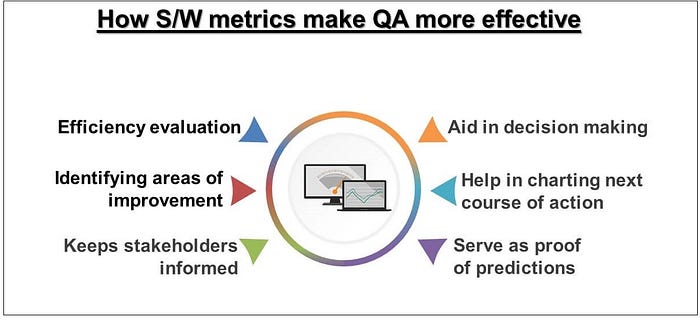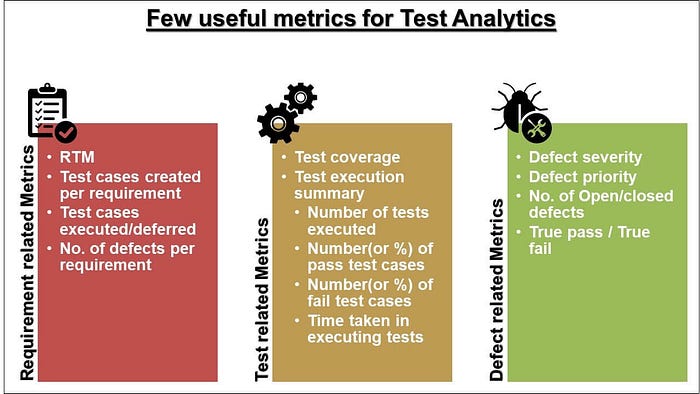What are software testing metrics?
As a project manager if you want to know how productive your team is. The answer “very productive” sounds good, but not enough to satisfy the higher management and business unit owners. They want to see the numbers to substantiate these claims.
Similarly, when asked about project progress, the answer “as per the schedule” is not the right answer when it comes to presenting it to the people who matter, i.e. customers. They want to see some tangible progress on board.
“What about the health of the project?” — “Very few defects here and there” will not cut it. Where are the numbers?
That is where software testing metrics step in.
Software testing metrics are quantifiable measures that help the business and technical stakeholders to determine a software project’s progress, quality, and people/process efficiency.
But, throwing in just some random numbers won’t help your cause unless they are in strong context with the project under development. It is important to consider the type of project, requirements, timelines, budget, and of course the quality process too before defining the metrics.
Types of software metrics
Software metrics can be broadly classified into 3 categories.

Project Metrics: These metrics help in evaluating project status, estimating variance in schedule/cost, assessing productivity, and quantifying defects to measure the project’s health.
Product Metrics: These metrics are based on product specifics like size, complexity, performance, etc. These are measured at different stages throughout the software development to ensure that the product is being developed as per the requirements.
Process Metrics: These are used to measure the efficiency of the software testing process based on the net outcome in terms of defect-related numbers within the specified timeline and budget. These numbers help in optimizing the process further for improved results.
For every metric type usually, there is a base metric and derived/calculated metric. Base metrics are specified during test planning and derived metrics are calculated by applying specific formulas.
The need for software testing metrics
Software testing metrics answer the questions that aid the managers, customers, decision-makers, and technical teams in making informed decisions about their projects.
MetricsWhat they tell you ROI on testing
- Did we overshoot the budget?
- Did we estimate the effort and skills correctly?
Time management
- Was the time earmarked for testing too little or extra?
- How time/efforts can be managed better to improve feature velocity
- Will the product be delivered on time?
Defect management
- How many defects were discovered?
- Were they fixed or deferred?
- Severity of defects
Test result analysis
- Was the testing effective?
- Was the test planning efficient?
- Is the product adhering to specified quality standards?
These are just a few examples, but when you sit down and start listing down the metrics, more questions will arise, that will get your think tank working to start deriving metrics pertinent to your software. Some metrics are relevant to the internal development and process teams, while some act as project health indicators for the management, and some act as flags for the customers.
Importance of software testing metrics (How they make QA process more effective)
Software metrics are the definite numbers that help the business/technical stakeholders to understand the efficacy of their process, monitor critical operations, evaluate the outcome of QAOps and then charter the future course of action based on the findings.
Let us understand how these metrics make the QA process more effective.

Efficiency evaluation:
The software metrics help you in understanding whether you were right about the budget or estimating the time based on the quantum and complexity of work. They also help you in evaluating the effectiveness of test planning and execution.
Identifying areas of improvement:
Do you want to understand the testing and patterns that emerge from the results? Software testing metrics are there to help you. They provide insights into software behavior and help the teams to observe and evaluate defect patterns, defect density, defect distribution
Keeps stakeholders informed:
No need for the managers and the customers to worry about slipped timelines or overshooting the estimates, because the metrics keep them all apprised about the project progress and quality
Help in decision making:
Now that all the concerned parties are equipped with the knowledge of quantifiable measures, it becomes much easier to make decisions about the project and optimization of process and resources.
Help in charting the next course of action:
With timely decisions made, it becomes even easier to plan for future work strategies.
Serves as proof for predictions:
Didn’t you set certain estimates at the outset of the project? These metrics will help in proving you right or wrong w.r.t. time, effort, cost, skill, etc.
Few useful metrics for test analytics
Let’s face the fact that it is a herculean task to track and measure every parameter during software development. Hence it is wise to identify the metrics that align with your business priorities, and they need to be analyzed and revisited from time to time. A few thumb rules that you need to follow for metrics independent of business are that they should be easy to understand, use consistent measurement units, adaptable, reliable, and accurate. This section will list down a few common metrics used in software development for you.

Requirements related:
Requirement related metrics help you in identifying, monitoring, and evaluating how effectively a requirement is translated to an error-free functionality and is working as expected.
Some examples of requirement related metrics are,
- Requirement traceability matrix(Trace defect to user story)
- Test cases created per requirement
- Test cases per requirement executed/deferred
- Requirement coverage
- Requirement defect density (Number of defects per requirement)
Test related:
Test related metrics help you in evaluating the efficacy and efficiency of your testing process. Some of the key metrics to measure that are listed below:
- Test coverage
- Test execution summary
- Number of tests executed
- Number(or %) of pass test cases
- Number(or %) of fail test cases
- Time taken in executing tests
- Automated test coverage(higher this percentage, lower are the chances of defects in the system)
Defect related:
Defects discovered during the testing have many stories to tell. They tell you how correctly the requirements were understood and then translated into functionality. They also tell you how skilled your workforce is by highlighting the quality of the module under test. Many defect-related metrics can be included in your testing process, some important ones are mentioned here.
- Defect severity
- Defect priority
- Number of open/closed defects
- True pass / true fail
Read for more:https://www.webomates.com/blog/intelligent-test-automation/test-analytics-with-ai-based-automation/


![Guardian Botanicals Blood Balance Formula Reviews [Updated 2024] & Order At Price For Sale](https://f002.backblazeb2.com/file/yoosocial/upload/photos/2024/10/dE3zDuqvcfRPYmRDGIM7_21_eedcce62b6c82006cb0016dde409ce0d_image.png)






